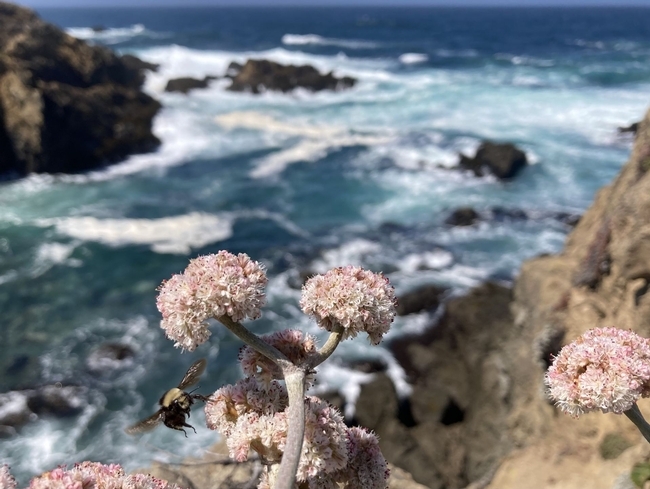- Author: Kathy Keatley Garvey
Fantastic title: "Bad Bugs, Pungent Parasites and Toxic Travelers!"
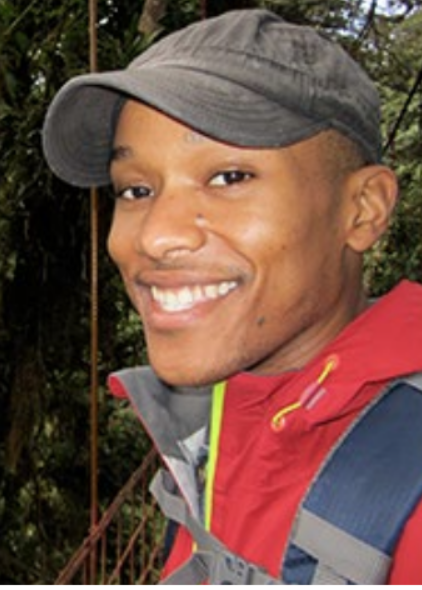
Jared Ali, an assistant professor at Pennsylvania State University, will speak on "Chemical Ecology of Plant Defense and Multi-Trophic Interactions: Bad Bugs, Pungent Parasites and Toxic Travelers" at the next seminar hosted by the UC Davis Department of Entomology an Nematology.
This will be both in-person and Zoom seminar. Ali will speak at 4:10 p.m., Wednesday, April 20 in 122 Briggs Hall. The Zoom link is https://ucdavis.zoom.us/j/
"The talk will broadly be on the behavior and chemical ecology of multi-trophic interactions," Ali says. "This includes plant responses to herbivory, nematode and insect chemical ecology, in agricultural and conservation contexts. Research projects include trophic cascades associated with cover crops, above-below-ground interactions, and the consequences of diet on insect dispersal."
His lab website delves into multi-trophic interactions and chemical ecology.
Ali served as a postdoctoral fellow at Cornell University (2011-2013) in ecology and evolutionary biology before joining Penn State faculty in the spring of 2016. He holds a bachelor's degree in biological sciences (2005) and a master's degree in entomology (2008) from the University of Delaware; and a doctorate in entomology (2011) from the University of Florida.
Ali's most recent publications include:
- Cover Crop Selection Affects Maize Susceptibility to the Fungal Pathogen Fusarium verticillioides, published in Trends in Plant Science.
- Plant Nutrition Influences Resistant Maize Defense Responses to the Fall Armyworm (Spodoptera frugiperda), published in Frontiers in Ecology and Evolution.
- Transcriptomic and Volatile Signatures Associated with Maize Defense against Corn Leaf Aphid, published in BMC Plant Biology.
- Chemical Cues from Entomopathogenic Nematodes Vary Across Three Species with Different Foraging Strategies, Triggering Different Behavioral Responses in Prey and Competitors, published in the Journal of Chemical Ecology.
- Cover Crop Soil Legacies Alter Phytochemistry and Resistance to Fall Armyworm (Lepidoptera: Noctuidae) in Maize, published in Environmental Entomology.
- Herbivore-Induced Plant Volatiles Mediate Behavioral Interactions Between a Leaf-Chewing and a Phloem-Feeding Herbivore, published in Basic and Applied Ecology.
Nematologist Shahid Siddique, assistant professor, UC Davis Department of Entomology and Nematology, is coordinating the spring seminars. For Zoom technical issues, contact him at ssiddique@ucdavis.edu.
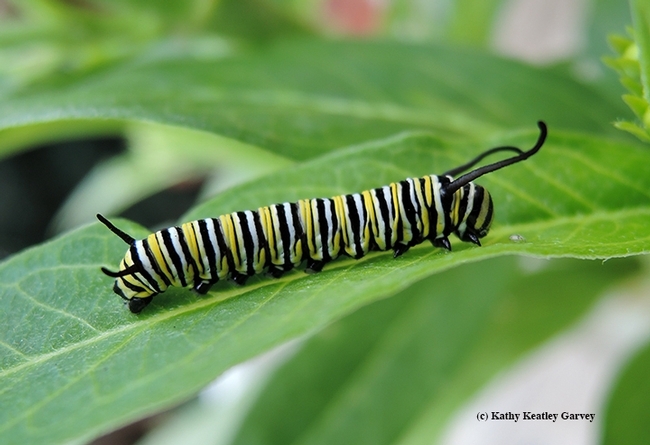
- Author: Kathy Keatley Garvey
Talk about a quail of a time....
When the ootheca of a praying mantis, Stagmomantis limbata, hatched April 9 on a clothespin clamped to our clothesline in our yard, all the nymphs scattered. Some crawled up a metallic quail sculpture, the highest structure on the clothesline. (See Bug Squad blog)
A bird's eye view? They scrambled about, covering the beak (beak-a-boo), the eyes and the tail (bright-eyed and bushy tailed), and the wings (were they just winging it?).
If a flock of quail is collectively known as a flock, covey or bevy, what is the collective noun for a group of mantids?
A mass of mantids? A pack of predators? A prayer meeting? Or a prey-er meeting? Brothers and sisters, we are gathered here today....let us prey.
Only a few will survive to maturity. Many have already been eaten by a brother or sister. And some will lose their head to a female suitor (sexual cannibalism).
Birds of a feather may flock together, but praying mantids do not. They keep their compound eyes on the prize, and spiked forelegs on their prey.
None would ever be nominated for Miss or Mr. Congeniality.
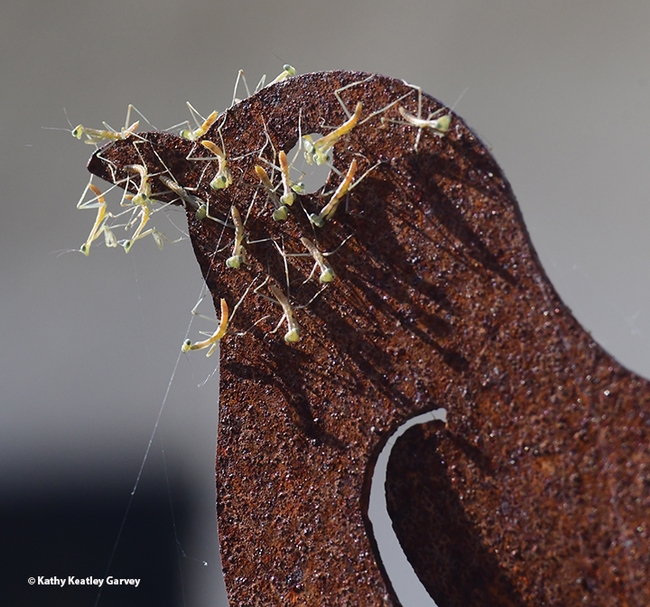
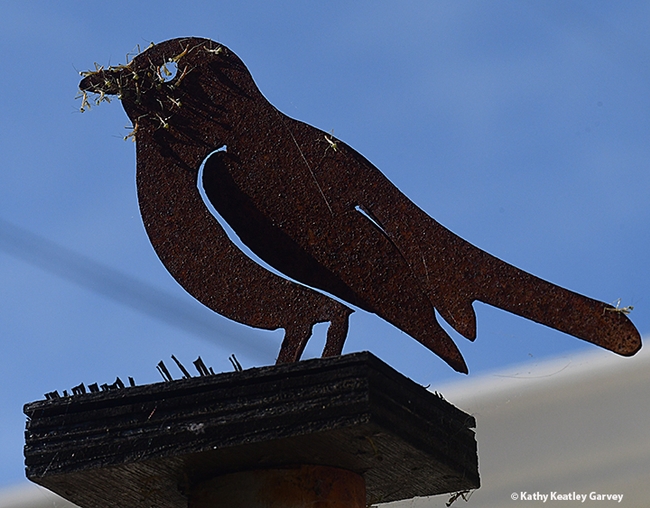
- Author: Kathy Keatley Garvey
Saturday, April 9 was the day a clothespin sprang to life.
Some 200 praying mantis nymphs emerged from an ootheca that Mama Mantis (Stagmomantis limbata) had deposited last summer in our pollinator garden in Vacaville.
We first noticed the camouflaged ootheca (aka eggcase or ooth) on the wooden clothespin in mid-March when we were hanging a freshly laundered dog blanket on the line.
Then on that warm Saturday, with temperatures edging 80 degrees, the clothespin exploded with life. From a distance, the nymphs looked like feathery little ants flicking about.
Mama's babies.
Looking a lot like Mama, they edged out of the ooth, crawled up and down the clothesline, and then some ascended a metallic quail sculpture, the highest point.
A bird's eye view.
Praying mantis experts say that only a handful will survive to maturity. Yes, they will eat one another, along with other small insects such as fruit flies and aphids. Then they will advance to larger prey.
When Sunday dawned, they were gone.
Mama's babies.
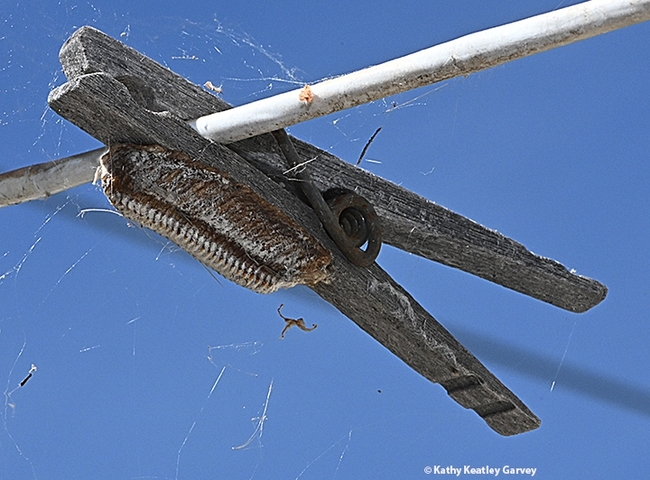
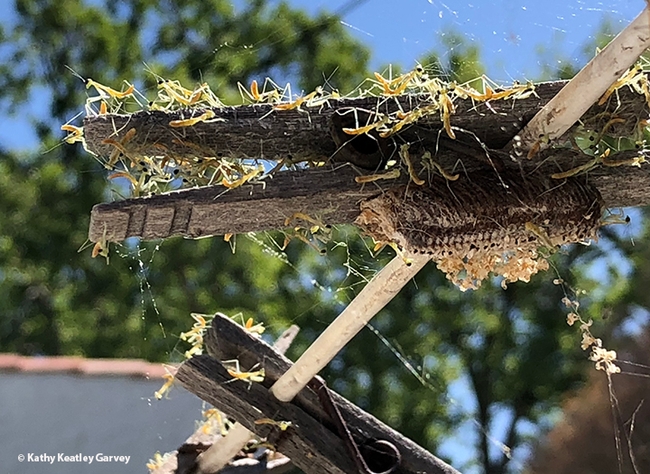
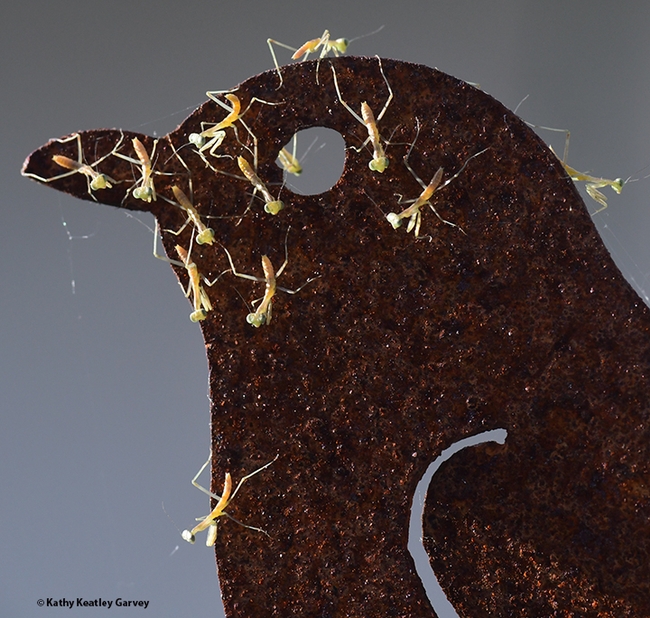
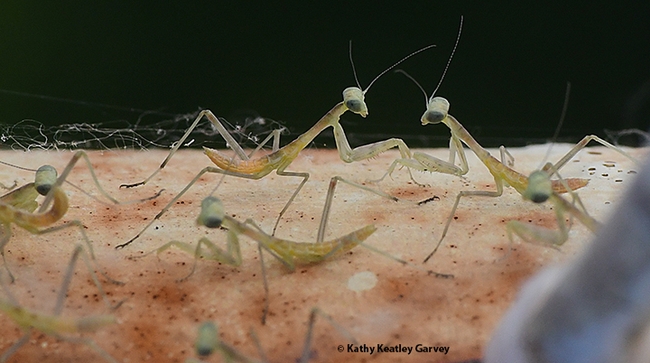
- Author: Kathy Keatley Garvey
Ladybug, ladybug fly away home
Your house is on fire and your children are gone
All except one, and her name is Ann
And she hid under the baking pan.
So says a traditional nursery rhyme traced back to 1744 when it appeared in Tommy Thumb's Pretty Songbook, according to Wikipedia. The first version has it as "Ladybird" instead of "Ladybug" and another version has it "Your house is on fire and your children will burn."
The nursery rhyme was meant to be a chant to shoo away the lady beetle (aka ladybug), according to freedictionarycom. It was "an allusion to the practice of farmers burning their fields after the harvest."
Nowadays, we're more interested in a ladybug's take-off and landings capabilities.
Have you ever tried to photograph the split second when a ladybug spreads its wings? It's not easy to do because insects are unpredictable, and you fingers and your camera shutter speed don't always cooperate, either. Beetle blur!
It's a marvelous feat, though.
Writer Joanna Klein said it best in her May 18, 2017 piece in the New York Times: "The ladybug is a tiny insect with hind wings four times its size. Like an origami master, it folds them up into a neat package, tucking them away within a slender sliver of space between its abdomen and the usually polka-dotted, harder wings that protect it. When it is time to take off, it deploys its flying apparatus from beneath its colorful shell-like top wings, called the elytra, in only a tenth of a second. And when it lands, it folds it back in just two. Switching between flying and crawling many times in a day, the ladybug travels vast distances." (See the news story and watch the video on how a ladybug tucks away its wings.)
Yes, the ladybug is an origami master.
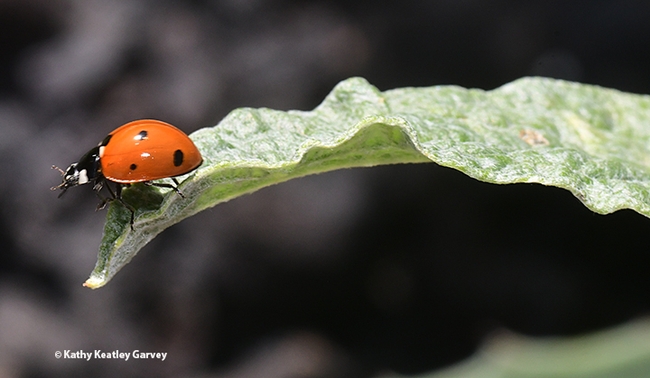
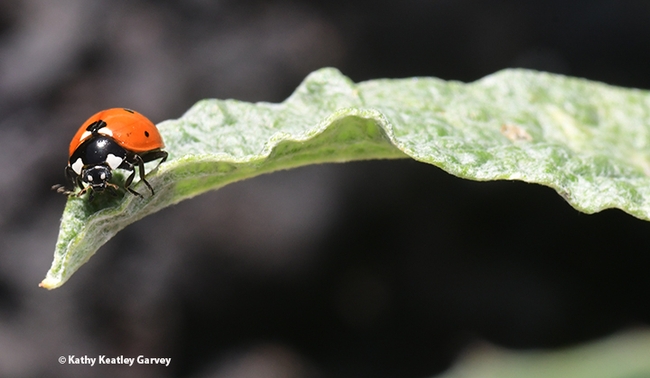
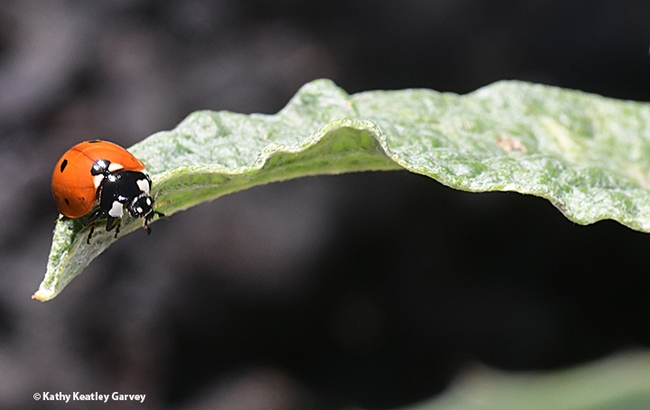
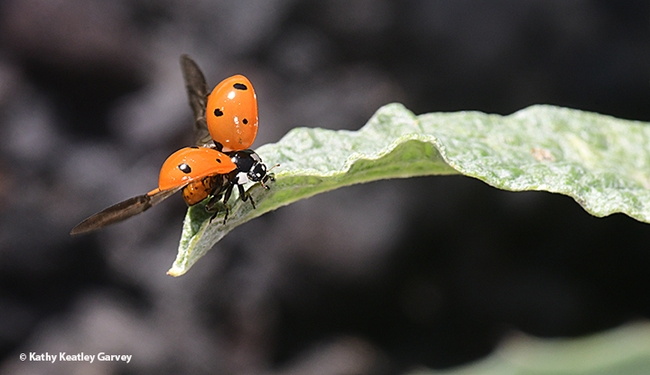
- Author: Kathy Keatley Garvey

Hammer, assistant professor of ecology and evolutionary biology, UC Irvine, will give the in-person and virtual seminar, hosted by the UC Davis Department of Entomology and Nematology, at 4:10 p.m. in 122 Briggs Hall. The Zoom link: https://ucdavis.zoom.us/j/99515291076.
Community ecologist Rachel Vannette, associate professor, UC Davis Department of Entomology and Nematology, is hosting the seminar.
"How do insects and microbes form symbioses, and why do these partnerships often break down?" Hammer asks in his abstract. "We are addressing these questions with the gut microbiomes of social corbiculate bees. Despite an ancient association with their bee hosts, these symbionts are surprising dynamic over developmental, ecological and macroevolutionary time scales. I will discuss our recent discoveries of symbiont loss in bees, and efforts to understand why and how these losses occur."
Hammer received his bachelor's degree in general biology from UC San Diego in 2009 and his doctorate in evolutionary biology in 2018 from the University of Colorado, Boulder. He served as a postdoctoral researcher at the University of Texas, Austin, from 2018 to 2021.
Hammer's research interests include microbiomes, symbiosis, microbial ecology and evolution, bees, biodiversity, insect-plant interactions and tropical biology.
"We are a new research group at UC Irvine studying the ecology and evolution of symbioses between hosts (especially bees) and microbes," he writes on his lab website.
Nematologist Shahid Siddique, assistant professor, UC Davis Department of Entomology and Nematology, is coordinating the spring seminars. For Zoom technical issues, contact him at ssiddique@ucdavis.edu.
